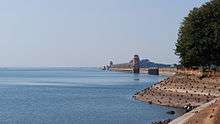Andhra Pradesh Power Generation Corporation
Andhra Pradesh Power Generation Corporation Limited is power generating organization in Andhra Pradesh. It undertakes operation and maintenance of the power plants and also setting up new power projects alongside upgrading the project's capacity.[2] Under the recommendations of Hittenbhayya committee setup by TDP Govt..
 | |
| Government-owned Corporation-PSU | |
| Industry | Electricity generation |
| Founded | 1998 |
| Headquarters | Vijayawada, India |
Key people | S.V.Prasad Chairman,K Vijayanand Managing Director[1] |
| Products | Electricity |
| Total assets | |
| Total equity | |
Number of employees | 10889 (2008) |
| Website | http://apgenco.gov.in/; http://appower.ap.gov.in/ |
History
The government reforms in power sector led to the formation of APGENCO on 28 December 1998 and commenced operations from 1 February 1999.[2] The imbalance of the revenues against the cost of production, no significant reduction in technical losses and energy thefts, high cost purchases from IPP's, other SEB's gradually worsened the financial position of APSEB.
APSEB division
Government of Andhra Pradesh realizing the declining tendency of the financial position of APSEB and considering the recommendations made by committee it was unbundled into Andhra Pradesh Power Generation Corporation (APGENCO) & Transmission Corporation of Andhra Pradesh Limited (APTRANSCO) on 1 February 1999 by AP Electricity REFORMS ACT.[3]
APTRANSCO was further unbundled w.e.f. 1 April 2000 into "Transmission Corporation" and four "Distribution Companies" (DISCOMS). From Feb 1999 to June 2005 APTransco remained as single buyer in purchasing and selling of power to DISCOMs.[3]
APGENCO formation and split
Later, on 2 June 2014, when the state was bifurcated, APGENCO distributed all the assets, liabilities and power stations to both the states and Telangana Genco (TSGENCO) was formed for the newly formed Telangana state and APGENCO remained for Andhra Pradesh in accordance with the Andhra Pradesh Reorganisation Act, 2014.[4]
Power plants
The total installed capacity of APGENCO, after the formation of TSGenCo is 4559.6 MW comprising 2810 MW Thermal, 1747.6 MW Hydro and 2 MW Wind power stations.[5] The Power Plants of APGENCO include thermal, hydel and wind based plants.[6][7]
Thermal projects
| Sl. No. | Project | Capacity (installed / under construction) (MW) |
Total (installed) (MW) | Gallery |
|---|---|---|---|---|
| 1 | Vijayawada TPP | 6×210 + 1×500 (Stage IV) | 1760 | |
| 2 | Rayalaseema TPP | 5×210 + 1×600 (Stage iv) | 1650 |  |
| Overall capacity | 3410.00 | 3410.00 | ||
Note: Simhadri Super Thermal plant (4x500 MW) and Damoadaram Sanjeevaiah Thermal Plant (2x800 MW) are not considered as they are not under the ownership of APGENCO.
Hydel projects

| Sr. No. | Project | Installed Capacity (MW) | Total (MW) |
|---|---|---|---|
| 1 | Chettipeta Mini Hydel | 2 x 0.5 | 1 |
| 2 | Donkarayi PH | 1 x 25 | 25 |
| 3 | Hampi Dam PH | 4 x 9 (AP Share – 28.8) |
28.8 |
| 4 | Lower Sileru PH | 4 x 115 | 460 |
| 5 | Machkund PH | 3 x 17 + 3 x 23 (AP Share – 84) |
84 |
| 6 | Nagarjuna Sagar RCPH | 3 x 30 | 90 |
| 7 | Penna Ahobilam PH | 2 x 10 | 20 |
| 8 | Srisailam RBPH | 7 x 110 | 770 |
| 9 | Tungabhadra Dam PH | 4 x 9 (AP Share – 28.8) |
28.8 |
| 10 | Upper Sileru PH | 4 x 60 | 240 |
| Overall capacity | 1747.6 | ||
Hydel projects (under construction)
| Sr. No. | Project | Installed Capacity (MW) | Total (MW) |
|---|---|---|---|
| 1 | Polavaram HEP | 12 x 80 | 960 |
| 2 | Nagarjuna Sagar tail pond PH | 2 x 25 | 50 |
| Overall capacity | 960 | ||
Non-conventional units
| Sl. No. | Project | Inst.Capacity (MW) | Total (MW) |
|---|---|---|---|
| 1 | Ramagiri Wind Mills | 10 x 0.2 | 2.0 |
| Overall capacity | 2.0 | ||
Source: Power Stations of AP after bifurcation into APGENCO and TGGENCO[8]
Operational performance
Though the performance of APGenCo thermal power stations in terms of reliability, availability and maintainability (RAM analysis) is one of the best in India,[9] its hydro power stations performance is satisfactory.monsoon season.[10] The thermal efficiency (heat rate) of thermal power stations is quite remarkable. Operating the thermal power stations in the range of 75 to 100% capacity in 'frequency follow mode' with good part load efficiency is the needful strategy in surplus electricity grid except during peak demand hours. Also Hydro power stations should perform well meeting all the functions such as power factor correction, peaking power generation, pumping water in pump mode and secondary power generation during monsoon season utilising total available water. This can be achieved by maintaining hydro power stations at availability more than 95%.[11]
See also
|
|
|
|
References
- Welcome to APGENCO Archived 19 December 2008 at the Wayback Machine
- "APGENGO overview". APGENCO. Archived from the original on 14 July 2014. Retrieved 19 June 2014.
- "History of APSEB". Transmission Corporation of AP. Archived from the original on 14 July 2014. Retrieved 19 June 2014.
- Sudheer Goutham (30 May 2014). "Power plants division between Andhra Pradesh and Telangana". Deccan Chronicle. Retrieved 7 June 2014.
- Salient features of AP TransCo. Retrieved on 2015-04-06.
- http://www.apgenco.gov.in/pdffiles/APGENCO%20Plants%20Location%20Map.pdf
- "Power projects of APGENCO" (PDF). apgenco.gov.in. Archived from the original (PDF) on 24 January 2013. Retrieved 7 June 2014.
- "GO 29 Transfer Scheme – AP Electricity Reforms Act, 1998". tgnns.com. 31 May 2014. Retrieved 7 June 2014.
- "APGenCo website main page". Retrieved 23 June 2014.
- "Power house at Srisailam submerged". Retrieved 23 June 2014.
- Managing historic flood in the Krishna river basin in the year 2009